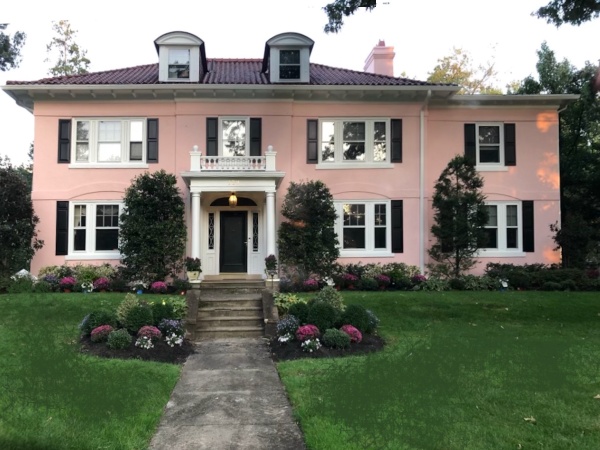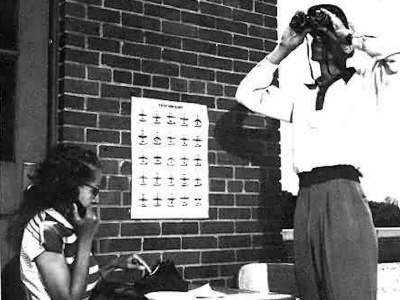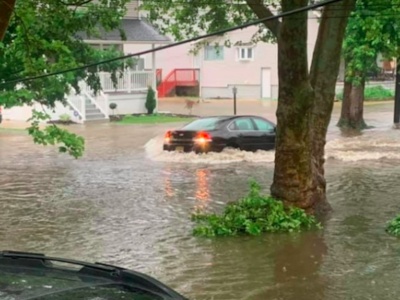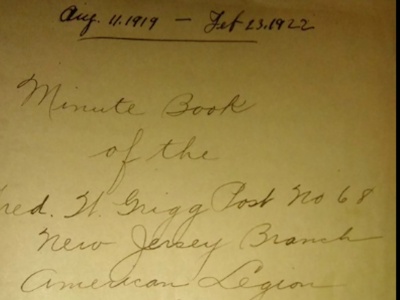History
During WWII, the east and west coasts of the United States were protected by civilian volunteer aircraft spotters, members of the Ground Observer Corps. The GOC was a component of the Aircraft Warning Service (AWS) that was established in May 1941 in response to the development of heavy bomber aircraft capable of flying over 1,000 miles to keep watch for enemy planes entering American airspace. It became inactive on May 29, 1944. Almost one million men and women volunteer “soldiers out of uniform” served in the AWS. In 1942, it became one of Merchantville's most popular outdoor sports with many teachers from Merchantville High School volunteering for tours of duty at a post located on Kresson Lake in Burlington County.
Completed in 1893, Collins-Pancoast Hall was home to both a building supply business and also served as a community meeting place and performing arts venue. John S. Collins, a sixth-generation Collins dating back to the seventeenth century, developed a successful coal and lumber business and then went to found and develop Miami Beach, Florida. Collins and his family's investment in the Miami area ultimately resulted in a building and tourism boom that helped the area grow into the urban community it is today. Though Collins left for Florida during the first decade of the twentieth century, The Collins family continued to operate the hall that not only served the business, but also the entire community as a civic and cultural center for numerous decades. A third-floor served as the Masonic meeting room from its 1893 opening until the 1970s. The Post Office used the building for a time, and the Merchantville Playcrafters used Collins Hall from 1937 until 1976.
The Oaks Historic District was listed on the National Register of Historic Places in 1997. "The Oaks," located in Merchantville, New Jersey, is a planned neighborhood of upscale, early-twentieth century suburban houses envisioned by landscape architect George E. Rhedemeyer and developed by the Oaks Realty Company which he formed in 1910. Designed during the early years of the automobile age and for the most part, before the First World War, The Oaks became Merchantville's twentieth-century showcase and its gateway for vehicular traffic entering the Borough from Wellwood Avenue, later renamed Browning Road, and includes 320 W. Maple Ave., 101-201 (odd numbers) Browning Rd, 308-318 (even numbers) Volan St., and 1-3 Oak Terrace. The Oaks Historic District contains an assemblage of the period's revival styles, several representatives of which were designed by Arnold H. Moses, long-time Merchantville resident and the Borough's most prolific architect during the first quarter of the twentieth century. Because The Oaks contains a concentrated group of Merchantville's most fashionable residences associated with the automobile age of the Borough's developmental history, and the resources reflect the discrete plan laid out by Rhedemeyer and the architectural work of Moses, the district is eligible for the National Register of Historic Places. The period of significance begins with Rhedemeyer's acquisition of the land in 1909 and terminates around 1937 when the last of the initial homes in The Oaks was built. Photograph by Carol Benenson Perloff, 1996.
Merchantville Antiques and Salvage came across a photo of his grandfather's Shoe Repair Shop the other day. The picture, taken in 1928, shows shop owner Orlando Ricci posing in front of his storefront. Upon finding this treasure, Michael and Jaclyn Ricci remarked on how amazing it is to think that in a couple years their family will have lived here for 100 years. Truly, one of the most valuable characteristics of Merchantville life is the rich history of each generation owning a small business at 37 South Centre - from shoe repair shop to luncheonette to dress shop, and now their antiques and lamp repair shop.
If you have a personal treasure you have been yearning to know its historical significance and value, we have a venue for you. Join us for the Annual Meeting of the Merchantville Historical Society on Wednesday, October 9th, at 8:00 p.m., at the Community Center. Go to the Merchantville Historical Society Facebook page to indicate you are attending. Those guests wishing to bring an item for evaluation, should select the appropriate box. The first 35 people, registering a submission, will have their pieces placed in a viewing area. Mike Ivankovich, professional appraiser, will expound on each item to the audience. We are pleased to have The Woman’s Club of Merchantville co-hosting the event. Peruse your attic or storage areas; register your participation and come to our antiques style road show.
Merchantville is a treasure trove of a variety of well-preserved styles of residential architecture. A classic mix of 19th and early 20th century architecture and tree-lined streets with beautifully maintained gardens define the historic borough and its vital downtown. Less than one square mile, Merchantville is home to almost 3,800 residents. Quaint and intimate, Merchantville offers an unprecedented and authentic sense of community. This interactive walking tour adapts and combines the Merchantville Historical Society's individual district tours. They can be walked separately or together depending what you choose to explore during your time in Merchantville. Detailed descriptions of the houses in each tract are linked to in the directions below or can be obtained in person at Borough Hall, One West Maple Avenue.
As far back as 1924 there are published reports of drainage issues and flooding on Glenwood Avenue in Merchantville. In The Morning Post (Camden, New Jersey) on December 23, 1924 the borough highway committee was reported to be working with Delaware Township (Cherry Hill) on railroad drainage issues. In July of 1925 eleven residents filed a complaint with Council about the lack of a proper drainage in the thoroughfare, and in September of 1926 authorization of $1,250 for a storm sewer to drain "the lake that forms at Holly and Glenwood avenues." In 1938, 1939 and 1940 referencing garage and home flooding, a county sponsored WPA ditch drainage project that would cross Glenwood Avenue thereby overwhelming the runoff system and opposition to the project by Merchantville's borough engineer and Council. In a May 1947 Courier-Post article Borough Council requested that Freeholders supply storm sewers to drain Glenwood Avenue stating, "Drainage of the area, which has been flooded several times, has been problem for nearly 20 years." and in August 1950 police reports that the 200 block of Glenwood was flooded and "pedestrians and cars could not get through". Borough Council reported in December 1951 that the drainage project on Glenwood Avenue was "making normal progress". Again, after a major storm in June 1969, flooding was reported on the "200 block of Glenwood Avenue." Ten years later, in March of 1979, resident Grace Green sent a letter to the Courier-Post chastising Councilwoman Yates and the mayor for condoning the existing water problem at Holly and Glenwood. The next searchable news about this comes from a Philadelphia Inquirer article on November 10, 1989 and p.2 titled, "Merchantville attacks problem of flooding on Glenwood Ave." It discusses the response to a serious flooding issue in October of that year. In 1992 the Inquirer, page 2 recorded the drainage issue as seen through the eyes of resident, Bob Press, sharing tales of knee-deep flooding four times a year. And from 1994, in a series of four articles - May, July, August and September - found in the Courier-Post and Philadelphia Inquirer, the ongoing saga of Glenwood Avenue is memorialized. In January of 1995 an $85,000 contract was awarded by Mayor and Council to VSP, Inc., Haddonfield to relocate and repair storm drains and pipes on Glenwood Avenue.
The day was August 11, 1919. A meeting was held In Merchantville by returning local doughboys to start a chapter of the newly formed Veterans group called the American Legion. 100 years later to the day we will return to spot where it all started. A very special post meeting that is open to the public as we reflect on those humble beginnings and pay tribute to our Post namesake, 19 year old resident Frederick W. Grigg. The meeting will be held upstairs in Council chambers as it was in the "old Borough Hall" 100 years ago. The meeting will begin at 12 noon. Following the meeting all are invited to raise a glass at Eclipse brewing to young Frederick and the rest of the doughboys who set into motion a century of service to our local Veterans. Join in on a singing of "Over There" as we proudly celebrate Merchantville Posts 100th Birthday! Hope you can join us.












